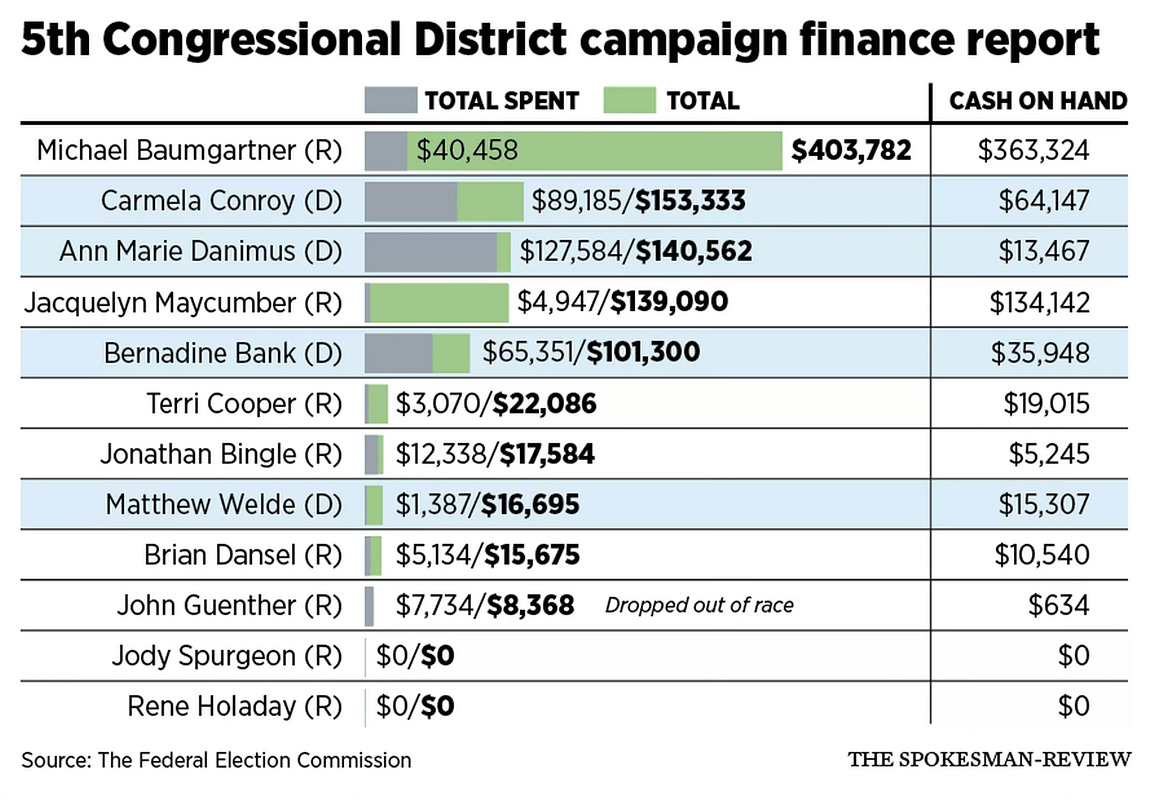How to look at them and what they might mean
All the candidates running in WA Congressional District 5 (eastern Washington) to replace retiring Republican U.S. Representative Cathy McMorris Rodgers had to file their campaign finance reports with the Federal Election Commission (FEC) by March 31. On Sunday, April 28, Emry Dinman presented data in the Spokesman that he had crunched from the campaign finance numbers accessible on fec.gov. Hats off to Mr. Dinman. Navigating the FEC website requires diligence. Here’s the summary of the dollar numbers from Mr. Dinman’s article:

The total amount raised by the Prefers Democratic Party candidates (Conroy, Danimus, Bank, and Welde) is, in round thousands, $412K. The total raised by the Prefers Republican Party candidates is $607K.
But let’s consider the numbers of contributors. Combing the numbers at fec.gov, the total number of contributors to campaigns of Democrats is 5,591. That is more than 9X the total of 616 individual contributors to Republicans. Ann Marie Danimus has been campaigning for many months longer than any of all the others, but, even so, her total number of individual donors is remarkable at 4179. Even if we discount that number as a wild outlier, the total Dem’s number of donors remaining is 1412 and that is still 2.3 times the number of donors to all the Republicans put together.
Baumgartner likes to brag about his fundraising prowess. He is quoted in the April 9th Spokesman, “It takes more than just money to win in politics, but this is a good benchmark of who has the momentum and who has the most supporters.” Self-serving BS. What Mr. Baumgartner did not tout, and for good reason, is that his haul of $404K came from less than half the number of donors of his closest competitor, Carmela Conroy (419 to 938). That is far, far less than Ann Marie Danimus’ 4179 contributors, and also less than Bernie Bank’s 454. Baumgartner is bragging about having a lot of monied contacts.
Jacqueline Maycumber’s numbers, the second biggest Republican fundraiser and fourth overall, are even more telling. Her entire haul of $139K comes from just 89 high dollar contributors.
Absolute numbers of dollars are important, but they are only part of the story. Numbers of contributors offers a different narrative. In the end it is the number of votes that counts. Insofar as numbers of contributors speaks of interest in the election, numbers of small dollar contributors speaks volumes.
Keep to the high ground,
Jerry
P.S. A few side notes:
- Yes, three of the four Democratic candidates for CD5 have a head start in small dollar donations, having begun their campaigns before McMorris Rodgers disclosed (at least publicly) that she was retiring after her current term ends at the end of this year. Time will likely change some of the ratios calculated above.
- Take note that fec.gov only reports on candidates for federal office, i.e. U.S. Reps, U.S. Senators, and the President/VP ticket. If you want to explore campaign finance for candidates for Washington statewide or local races you need to go to the Washington State Public Disclosure Commission, pdc.wa.gov. There you’ll need to mount a new and different learning curve.
- Figuring out actual donor’s names on fec.gov is an interesting challenge thanks to Actblue (established 2004) and WinRed (established 2019). Click the names to read interesting Wikipedia articles. Both are political action committees (PACs) that mostly serve to facilitate the collection of campaign contributions for Democratic and Republican candidates, respectively. Actblue, acting a lot like a credit card company, skims 3.9% off the electronic donations processed through the platform. WinRed skims a similar amount. That said, both make donating to a candidate’s campaign something that can be done on the spur of the moment unhampered by writing a check, addressing an envelope, finding the postage and putting the donation in the mail. No doubt the convenience they offer has stimulated contributions that might not otherwise have been made. Both PACs make researching contributors to federal candidates more challenging. A contribution made through either of them appears on the candidates’ pages with the PAC name only. To figure out who the actual contributor is requires several additional time-consuming steps.